Green Approach in Water-Based Drilling Mud Design to Increase Wellbore Stability
Abstract
:1. Introduction
2. Materials and Methods
2.1. Preparation of Powder from Mandarin Peel
2.2. Preparation of Quartz–Bentonite Pellets
2.3. Preparation of Drilling Mud
- bentonite-based drilling mud (BM);
- four drilling mud samples containing different concentrations of MPP with particle size of less than 0.1 mm (marked A1–A4);
- four drilling mud samples containing different concentrations of MPP with particle size from 0.1 to 0.16 mm (marked B1–B4).
2.4. Laboratory Test Equipment and Test Procedures
3. Results
4. Discussion
5. Conclusions
- MPP added to water-based mud reduces API filtration, PPT filtration, spurt loss, and pellet swelling regardless of particle size and concentration;
- the best results were obtained by adding MPP with particles from 0.10 to 0.16 mm at a concentration of 2% by volume of water;
- a 44% reduction in API filtration was achieved with mud B4 containing MPP particles from 0.10 to 0.16 mm at a concentration of 2% by volume of water;
- a 61.54% reduction in PPT filtration through a 0.75 μm2 (750 mD) ceramic disk was achieved with mud B4 containing MPP particles from 0.10 to 0.16 mm at a concentration of 2% by volume of water;
- a 53.85% reduction in PPT filtration through a 0.4 μm2 (400 mD) ceramic disk was achieved with mud B4 containing MPP particles from 0.10 to 0.16 mm at a concentration of 2% by volume of water;
- a 45% reduction in pellet swelling after 24 h was measured with mud B4 containing MPP particles from 0.10 to 0.16 mm at a concentration of 2% by volume of water at room temperature;
- a 48.6% reduction in pellet swelling after 24 h was obtained with mud B4 containing MPP particles from 0.10 to 0.16 mm added at a concentration of 2% by volume of water at 90 °C;
- satisfactory results were obtained up to a MPP concentration of 1% by volume of water;
- the swelling reduction results correlated very well with the API filtration reduction results.
Author Contributions
Funding
Institutional Review Board Statement
Informed Consent Statement
Data Availability Statement
Conflicts of Interest
References
- Khodja, M.; Canselier, J.P.; Bergaya, F.; Fourar, K.; Khodja, M.; Cohaut, N.; Benmounah, A. Shale Problems and Water-Based Drilling Fluid Optimisation in the Hassi Messaoud Algerian Oil Field. Appl. Clay Sci. 2010, 49, 383–393. [Google Scholar] [CrossRef] [Green Version]
- Albooyeh, M.; Kivi, I.R.; Ameri, M. Promoting wellbore stability in active shale formations by water-based muds: A case study in Pabdeh shale, Southwestern Iran. J. Nat. Gas Sci. Eng. 2018, 56, 166–174. [Google Scholar] [CrossRef]
- Pašić, B.; Gaurina-Međimurec, N.; Mijić, P.; Medved, I. Experimental research of shale pellet swelling in nano-based drilling muds. Energies 2020, 13, 6246. [Google Scholar] [CrossRef]
- Labenski, F.; Reid, P.; Santos, H. Drilling Fluids Approaches for Control of Wellbore Instability in Fractured Formations. In Proceedings of the SPE/IADC Middle East Drilling Technology Conference & Exhibition, Abu Dhabi, United Arab Emirates, 20–22 October 2003. [Google Scholar]
- Osuji, C.E.; Chenevert, M.E.; Sharma, M.M. Effect of Porosity and Permeability on the Membrane Efficiency of Shales. In Proceedings of the SPE Annual Technical Conference and Exhibition, Denver, CO, USA, 21–24 September 2008. [Google Scholar]
- Qu, Y.; Lai, X.; Zou, L.; Su, Y. Polyoxyalkyleneamine as Shale Inhibitor in Water-Based Drilling Fluids. Appl. Clay Sci. 2009, 44, 265–268. [Google Scholar] [CrossRef]
- Gaurina-Međimurec, N.; Pašić, B. Risk Due to Wellbore Instability. In Risk Analysis for Prevention of Hazardous Situations in Petroleum and Natural Gas Engineering; Matanović, D., Gaurina-Međimurec, N., Simon, K., Eds.; IGI Global: Hershey, PA, USA, 2014; pp. 23–46. [Google Scholar]
- Pašić, B.; Međimurec, N.G.; Matanović, D. Wellbore instability: Causes and consequences. Rud.-Geološko-Naft. Zb. 2007, 19, 87–98. [Google Scholar]
- Ballard, T.J.; Beare, S.P.; Lawless, T.A. Fundamentals of Shale Stabilization: Water Transport through Shales. SPE Form. Eval. 1994, 9, 129–134. [Google Scholar] [CrossRef]
- Gaurina-Međimurec, N. Mechanical Factors of Wellbore Instability. Nafta 1994, 45, 161–170. [Google Scholar]
- Fink, J.K. Petroleum Engineer’s Guide to Oil Field Chemicals and Fluids; Gulf Professional Publishing: Waltham, WA, USA, 2011; p. 785. [Google Scholar]
- McLean, M.R.; Addis, M.A. Wellbore Stability Analysis: A Review of Current Methods of Analysis and Their Field Application. In Proceedings of the IADC/SPE Drilling Conference, Houston, TX, USA, 27 February–2 March 1990. [Google Scholar]
- Zhang, J.; Yu, M.; Al-Bazali, T.M.; Ong, S.; Chenevert, M.E.; Sharma, M.M.; Clark, D.E. Maintaining the Stability of Deviated and Horizontal Wells: Effects of Mechanical, Chemical, and Thermal Phenomena on Well Designs. In Proceedings of the SPE International Oil & Gas Conference and Exhibition, Beijing, China, 5–7 December 2006. [Google Scholar]
- Steiger, R.P. Fundamentals and Use of Potassium/Polymer Drilling Fluids to Minimize Drilling and Completion Problems Associated with Hydratable Clays. J. Pet. Technol. 1982, 34, 1661–1670. [Google Scholar] [CrossRef]
- Bol, G.M.; Wong, S.-W.; Davidson, C.J.; Woodland, D.C. Borehole Stability in Shales. SPE Drill. Completion 1994, 9, 87–94. [Google Scholar] [CrossRef]
- Ewy, R.T.; Stankovich, R.J. Shale-Fluid Interactions Measured under Simulated Downhole Conditions. In Proceedings of the SPE/ISRM Rock Mechanics Conference, Irving, TX, USA, 20–23 October 2002. [Google Scholar]
- Wilson, M.J.; Wilson, L. Clay mineralogy and shale instability: An alternative conceptual analysis. Clay Miner. 2014, 49, 127–145. [Google Scholar] [CrossRef] [Green Version]
- El-Anwar, A.; Salman, S.; Mousa, D.; Aita, S.; Makled, W.; Gentzis, T. Organic Petrographic and Geochemical Evaluation of the Black Shale of the Duwi Formation, El Sebaiya, Nile Valley, Egypt. Minerals 2021, 11, 1416. [Google Scholar] [CrossRef]
- Steiner, I.; Gaurina-Međimurec, N. Borehole Stability Study with Various Formation Cores and Inhibitive Fluid Samples. In Proceedings of the Offshore Mediterranean Conference and Exhibition, Ravenna, Italy, 15–17 March 1995. [Google Scholar]
- Sauki, A.; Shah, M.S.Z.; Bakar, W.Z.W. Application of Ester based drilling fluid for shale gas drilling. IOP Conf. Ser. Mater. Sci. Eng. 2015, 83, 012012. [Google Scholar] [CrossRef] [Green Version]
- Arinkoola, A.; Salawudeen, T.; Salam, K.; Jimoh, M.; Atitebi, Z.; Abidemi, G. Optimization of Water Based Drilling Fluid Produced Using Modified Nigerian Bentonite and Natural Biopolymers: Reduced experiment and Response Surface Methodology. Iran. J. Chem. Eng. 2019, 16, 39–53. [Google Scholar]
- Gamal, H.; Elkatatny, S.; Basfar, S.; Al-Majed, A. Effect of pH on rheological and filtration properties of water-based drilling fluid based on bentonite. Sustainability 2019, 11, 6714. [Google Scholar] [CrossRef] [Green Version]
- Ewy, R.T.; Morton, E.K. Wellbore-Stability Performance of Water-Based Mud Additives. SPE Drill. Completion 2009, 24, 390–397. [Google Scholar] [CrossRef]
- Zhang, J.; Chenevert, M.E.; Al-Bazali, T.; Sharma, M.M. A New Gravimetric-Swelling Test for Evaluating Water and Ion Uptake in Shales. In Proceedings of the SPE Annual Technical Conference and Exhibition, Houston, TX, USA, 26–29 September 2004. [Google Scholar]
- Rojas, J.C.; Clark, D.E.; Zhang, J. Stressed Shale Drilling Strategy-Water Activity Design Improves Drilling Performance. In Proceedings of the SPE Annual Technical Conference and Exhibition, San Antonio, TX, USA, 24–27 September 2006. [Google Scholar]
- Han, G.; Timms, A.; Henson, J.; Aziz, I.A. Wellbore stability study: Lessons and learnings from a tectonically active field. In Proceedings of the Asia Pacific Oil and Gas Conference & Exhibition, Jakarta, Indonesia, 4–6 August 2009. [Google Scholar]
- Song, J.; Yuan, Y.; Gu, S.; Yang, X.; Yue, Y.; Cai, J.; Jiang, G. 2D numerical simulation of improving wellbore stability in shale using nanoparticles based drilling fluid. Energies 2017, 10, 651. [Google Scholar] [CrossRef] [Green Version]
- Gholami, R.; Elochukwu, H.; Fakhari, N.; Sarmadivaleh, M. A review on borehole instability in active shale formations: Interactions, mechanisms and inhibitors. Earth-Sci. Rev. 2018, 177, 2–13. [Google Scholar] [CrossRef] [Green Version]
- Darwesh, A.; Rasmussen, T.M.; Al-Ansari, N. Wiper Trips Effect on Wellbore Instability Using Net Rising Velocity Methods. Open Pet. Eng. J. 2018, 11, 14–28. [Google Scholar] [CrossRef]
- Anderson, R.L.; Ratcliffe, I.; Greenwell, H.C.; Williams, P.A.; Cliffe, S.; Coveney, P.V. Clay swelling—A challenge in the oilfield. Earth-Sci. Rev. 2010, 98, 201–216. [Google Scholar] [CrossRef]
- Aftab, A.; Ismail, A.R.; Ibupoto, Z.H. Enhancing the rheological properties and shale inhibition behavior of water-based mud using nanosilica, multi-walled carbon nanotube, and graphene nanoplatelet. Egypt. J. Pet. 2017, 26, 291–299. [Google Scholar] [CrossRef] [Green Version]
- May, P.; Deville, J.; Miller, J.; Burrows, K. Environmentally Acceptable Shale Inhibitors for High Performance Water-Based Muds. In Proceedings of the International Petroleum Technology Conference, Dhahran, Saudi Arabia, 13–15 January 2020. [Google Scholar]
- Amanullah, M. Screening and Evaluation of Some Environment-Friendly Mud Additives to Use in Water-Based Drilling Muds. In Proceedings of the SPE E & P Environmental and safety conference, Galveston, TX, USA, 5–7 March 2007. [Google Scholar]
- Ghaleh, S.P.; Khodapanah, E.; Tabatabaei-Nezhad, S.A. Experimental evaluation of thiamine as a new clay swelling inhibitor. Pet. Sci. 2020, 17, 1616–1633. [Google Scholar] [CrossRef]
- Al-Hameedi, A.T.; Alkinani, H.H.; Dunn-Norman, S.; Alashwak, N.A.; Alshammari, A.F.; Alkhamis, M.M.; Albazzaz, H.F.; Mutar, R.A.; Alsaba, M.T. Environmental friendly drilling fluid additives: Can food waste products be used as thinners and fluid loss control agents for drilling fluid? In Proceedings of the SPE Symposium: Asia Pacific Health, Safety, Security, Environment and Social Responsibility, Kuala Lumpur, Malaysia, 23–24 April 2019.
- Al-Hameedi, A.T.; Alkinani, H.H.; Dunn-Norman, S.; Alkhamis, M.M.; Feliz, J.D. Full-set measurements dataset for a water-based drilling fluid utilizing biodegradable environmentally friendly drilling fluid additives generated from waste. Data Brief 2020, 28, 104945. [Google Scholar] [CrossRef]
- Yalman, E.; Depci, T.; Federer-Kovacs, G.; Al Khalaf, H. A New Eco-Friendly and Low Cost Additive in Water-Based Drilling Fluids. Rud.-Geološko-Naft. Zb. 2021, 36, 5. [Google Scholar] [CrossRef]
- Zhang, L.; Wu, X.; Sun, Y.; Cai, J.; Lyu, S. Experimental study of the pomelo peel powder as novel shale inhibitor in water-based drilling fluids. Energy Explor. Exploit. 2020, 38, 569–588. [Google Scholar] [CrossRef]
- Al-Hameedi, A.T.; Alkinani, H.H.; Dunn-Norman, S.; Alkhamis, M.M.; Alshammari, A.F.; Al-Alwani, M.A.; Mutar, R.A. Controlling Drilling Fluid Properties Using Bio-Degradable Environmental Friendly Additives: Comparison between Conventional Chemical (PAC-LV) and Eco-Friendly Drilling Fluid Additives. In Proceedings of the 53rd US Rock Mechanics/Geomechanics Symposium, New York, NY, USA, 23–26 June 2019. [Google Scholar]
- Al-Hameedi, A.T.; Alkinani, H.H.; Dunn-Norman, S.; Al-Alwani, M.A.; Al-Bazzaz, W.H.; Alshammari, A.F.; Albazzas, H.W.; Mutar, R.A. Experimental investigation of bio-enhancer drilling fluid additive: Can palm tree leaves be utilized as a supportive eco-friendly additive in water-based drilling fluid system? J. Pet. Explor. Prod. Technol. 2020, 10, 595–603. [Google Scholar] [CrossRef] [Green Version]
- Ghaderi, S.; Haddadi, S.A.; Davoodi, S.; Arjmand, M. Application of sustainable saffron purple petals as an eco-friendly green additive for drilling fluids: A rheological, filtration, morphological, and corrosion inhibition study. J. Mol. Liq. 2020, 315, 113707. [Google Scholar] [CrossRef]
- Al-Saba, M.T.; Amadi, K.W.; Al-Hadramy, K.O.; Dushaishi, M.F.; Al-Hameedi, A.; Alkinani, H. Experimental investigation of bio-degradable environmental friendly drilling fluid additives generated from waste. In Proceedings of the SPE International Conference and Exhibition on Health, Safety, Security, Environment, and Social Responsibility, Abu Dhabi, United Arab Emirates, 16–18 April 2018. [Google Scholar]
- Al-Hameedi, A.T.; Alkinani, H.H.; Dunn-Norman, S.; Hamoud, Z.A. Investigation Study of the Effectiveness of Eggshells Powder as a Multifunctional Eco-Friendly Additive in Water-Based Fluid. In Proceedings of the 54th US Rock Mechanics/Geomechanics Symposium, Golden, CO, USA, 28 June–1 July 2020. [Google Scholar]
- ISO 10414-1; Recommended Practice for Field Testing Water-Based Drilling Fluids. API Recommended Practice 13B-1; American Petroleum Institute: Washington, DC, USA, 2003.
- Permeability Plugging Tester Instruction Manual; Version 5.0; OFI Testing Equipment, Inc.: Houston, TX, USA, 2015.
- Medved, I.; Gaurina-Međimurec, N.; Mavar, K.N.; Mijić, P. Waste mandarin peel as an eco-friendly water-based drilling fluid additive. Energies 2022, 15, 2591. [Google Scholar] [CrossRef]
- Ojha, P.; Karki, T.B.; Sitaula, R. Physio-chemical and functional quality evaluation of mandarin peel powder. J. Agric. Sci. Tech. 2016, 18, 575–582. [Google Scholar]
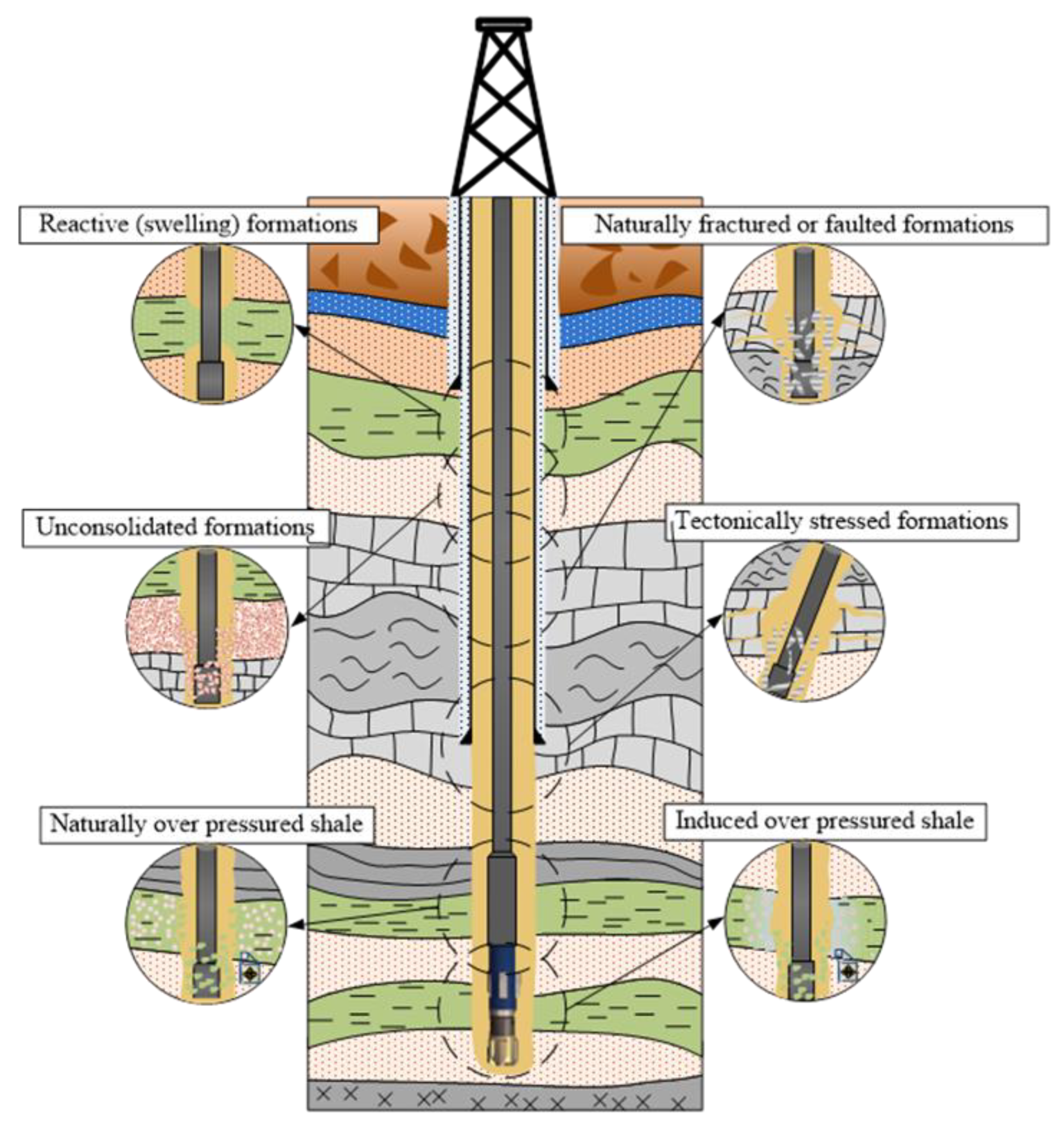

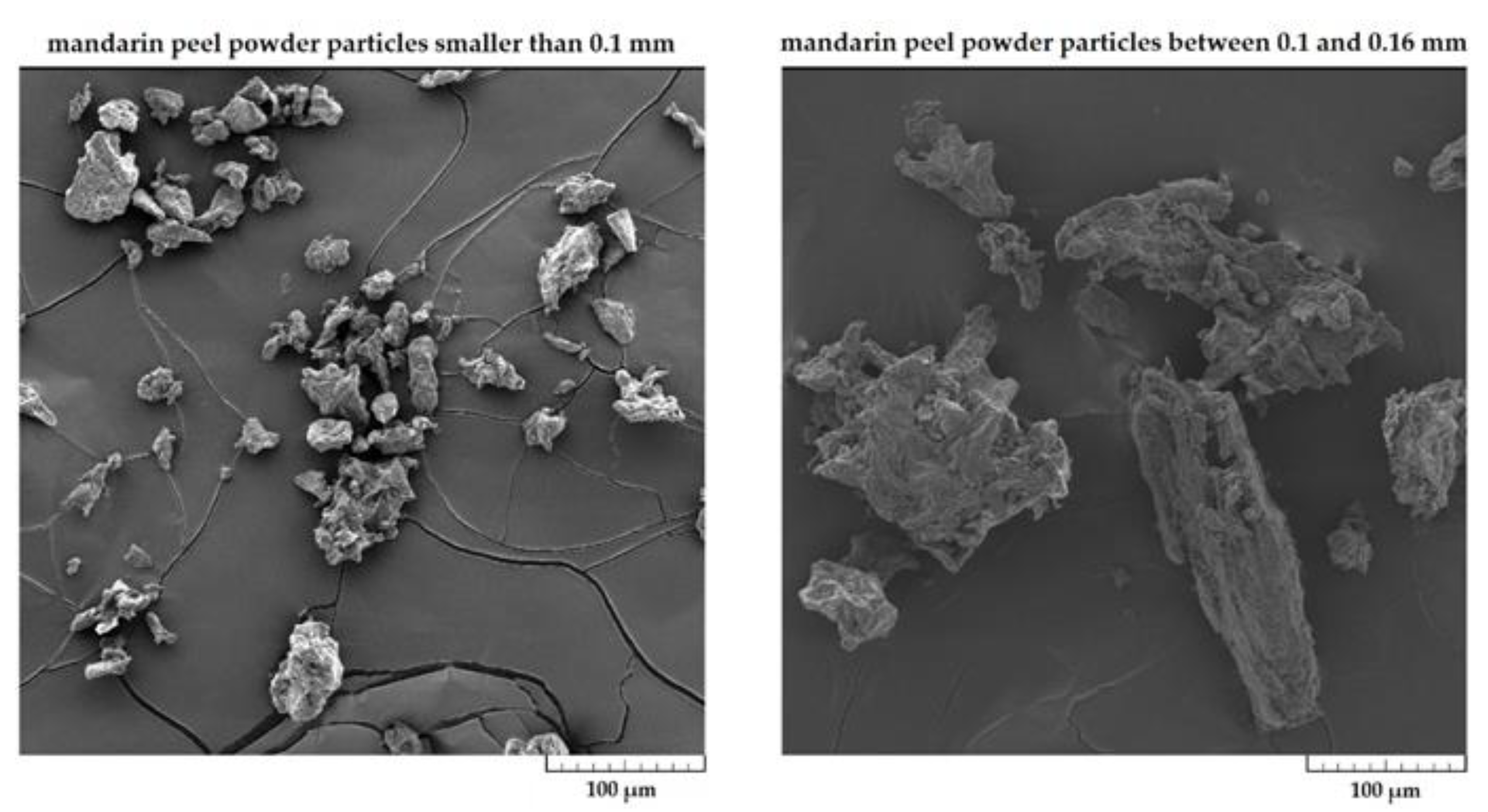
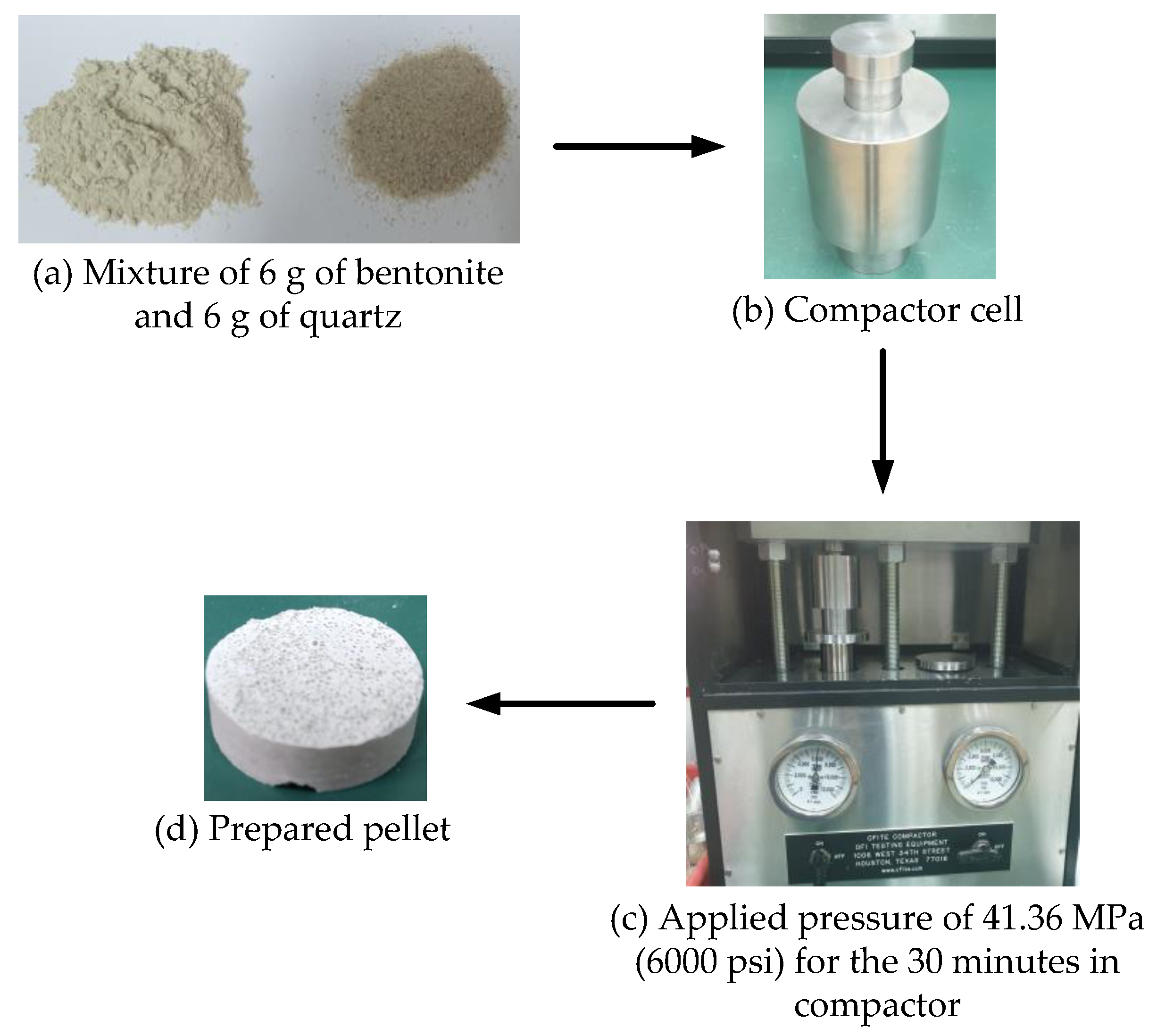




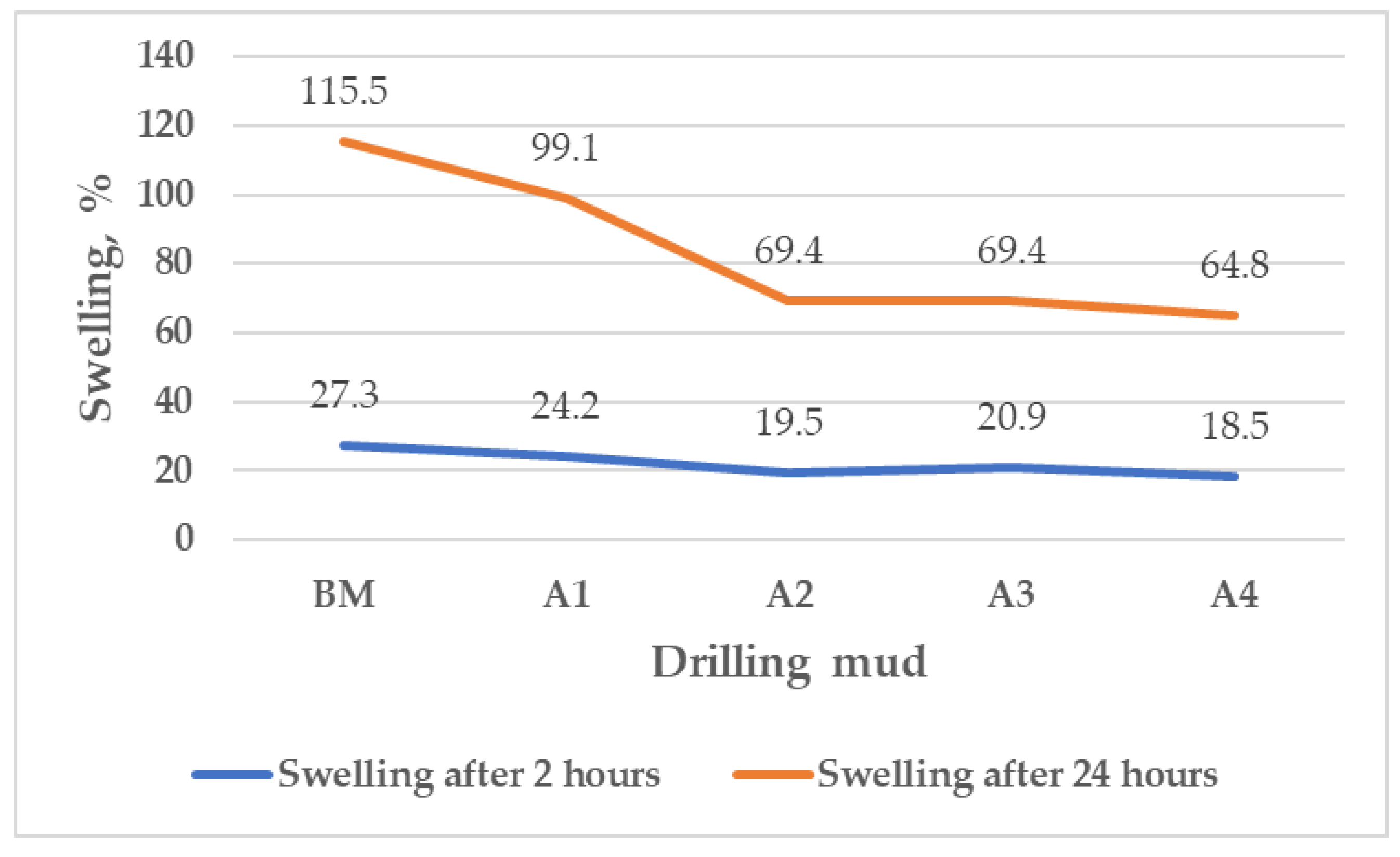
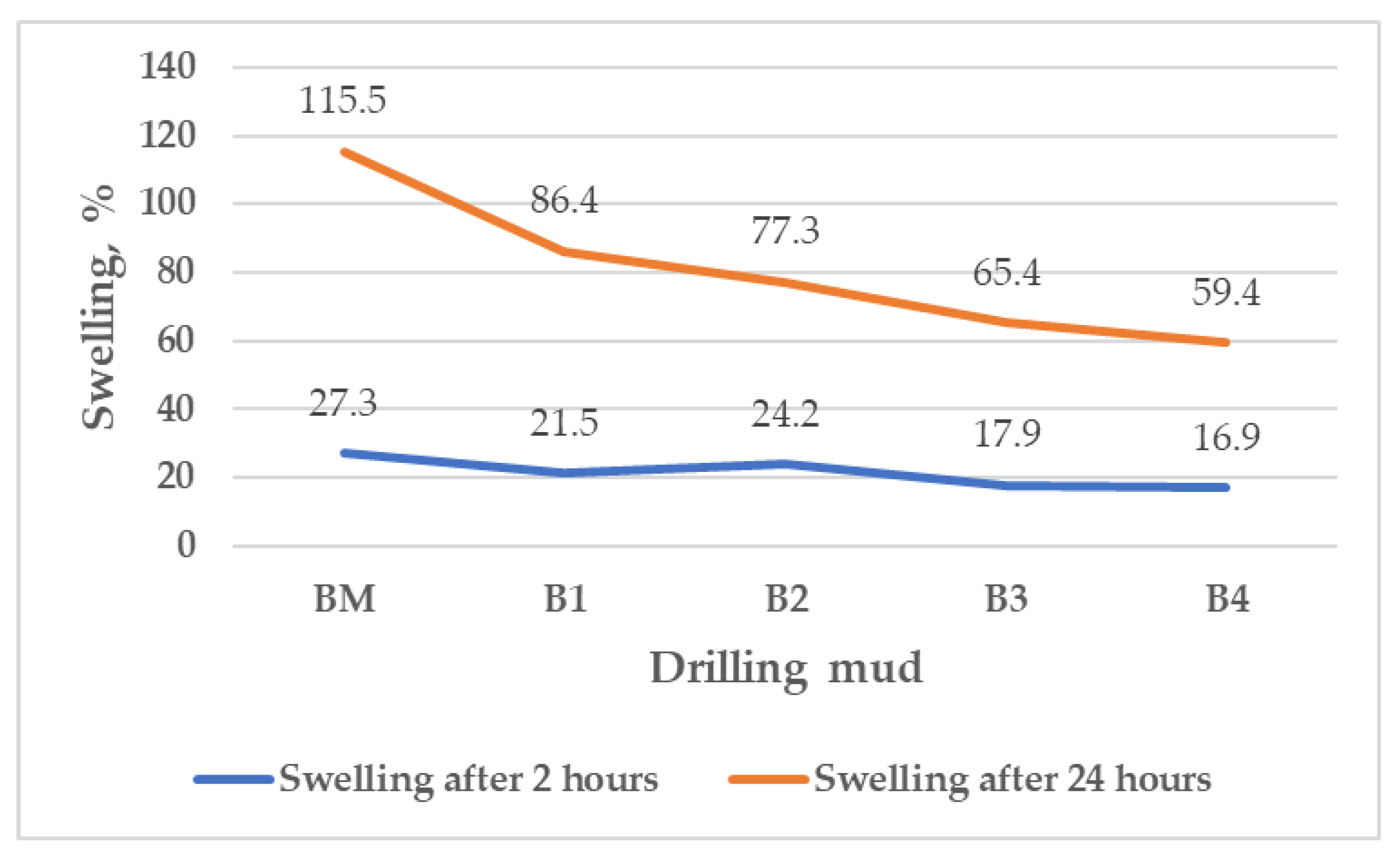

| Literature | Waste Material | Concentration (%) by Volume of Water | Highest Measured Reduction in Filtration (%) |
|---|---|---|---|
| Al-Hameedi et al., 2019 and 2020 [35,36,39,40] | Potato peel | 1, 2, 3, 4 | 30 |
| Mandarin peel | 68 | ||
| Fibrous food | 1, 2 | 30 | |
| Palm tree leaves | 1.5, 3 | 32 | |
| Grass | 0.5, 1, 1.5 | 48 | |
| Green olive pits | 0.75 and 1.5 | 16.7 | |
| Ghaderi et al., 2020 [41] | Saffron purple petals | 1, 2, 3 | 45 |
| Al-Saba et al., 2018 [42] | Banana peel | 0.285, 0.57, 1.425 | 32 |
| Olive pulp | 0.57 | 44 | |
| Corncob | 0.57, 1.71, 2.85 | 46.4 | |
| Corn starch | 0.57 | 20.8 | |
| Pomegranate peel | 0.57 | 20.0 | |
| Tamarind gum | 1.425, 2.85 | 64.0 | |
| Peach pulp | 1.425 | 44.0 | |
| Soya bean peel | 1.425 | 60.0 | |
| Sugar cane | 1.425 | 28.8 | |
| Henna | 1.71, 2.85 | 48.0 | |
| Coconut shell | 1.71, 2.85 | 52.0 | |
| Zhang et al., 2020 [38] | Pomelo peel | 1 | 26.2 |
| Al-Hameedi et al., 2020 [43] | Egg shell | 0.75, 1.5 | 34.6 |
| Yalman et al., 2021 [37] | Rice husk ash | 2.1, 4.3, 7.5, 9.6, 13.4, 16 | 9.6 |
| Tested Mud | Mandarin Peel Particle Size | Mandarin Peel Powder Concentration, % by Volume of Water |
|---|---|---|
| A1 | Less than 0.1 mm | 0.5 |
| A2 | 1 | |
| A3 | 1.5 | |
| A4 | 2 | |
| B1 | From 0.1 to 0.16 mm | 0.5 |
| B2 | 1 | |
| B3 | 1.5 | |
| B4 | 2 |
| Drilling Muds | ||||||||
|---|---|---|---|---|---|---|---|---|
| BM | A1 | A2 | A3 | A4 | B1 | B2 | B3 | B4 |
| Mandarin peel powder concentration (%) by volume of water | ||||||||
| 0 | 0.5 | 1 | 1.5 | 2 | 0.5 | 1 | 1.5 | 2 |
| API filtration (mL) | ||||||||
| 18 | 13.5 | 13.5 | 11.5 | 11.5 | 16 | 13 | 10.5 | 10 |
| Differential Pressure—3.447 MPa Temperature—88 °C | ||||||||||
|---|---|---|---|---|---|---|---|---|---|---|
| Disc permeability | 0.4 μm2 (400 mD) | 0.75 μm2 (750 mD) | ||||||||
| Drilling mud | BM | A2 | A4 | B2 | B4 | BM | A2 | A4 [46] | B2 | B4 [46] |
| V7.5, mL | 15 | 8 | 7.5 | 9.5 | 7 | 17 | 12.5 | 8 | 10.5 | 6 |
| V30, mL | 26 | 15 | 13 | 16 | 12 | 26 | 18.5 | 11 | 17.5 | 10 |
| PPT filtrate volume, mL | 52 | 30 | 26 | 32 | 24 | 52 | 37 | 22 | 35 | 20 |
| Spurt loss, mL | 8 | 2 | 4 | 6 | 4 | 16 | 13 | 10 | 7 | 4 |
| Drilling Mud | |||||||
|---|---|---|---|---|---|---|---|
| A1 | A2 | A3 | A4 | B1 | B2 | B3 | B4 |
| Reduction in API filtration (%) | |||||||
| 25 | 25 | 36 | 36 | 11 | 28 | 42 | 44 |
| Reduction in PPT filtration (%) through 0.4 μm2 (400 mD) disk | |||||||
| - | 42.31 | - | 50 | - | 38.46 | - | 53.85 |
| Reduction in PPT filtration (%) through 0.75 μm2 (750 mD) disk | |||||||
| - | 28.85 | - | 57.69 | - | 32.69 | - | 61.54 |
| Reduction in spurt loss volume (%) through 0.40 μm2 (400 mD) disk | |||||||
| - | 75 | - | 50 | - | 25 | - | 50 |
| Reduction in spurt loss volume (%) through 0.75 μm2 (750 mD) disk | |||||||
| - | 18.75 | - | 37.5 | - | 56.25 | - | 75 |
Publisher’s Note: MDPI stays neutral with regard to jurisdictional claims in published maps and institutional affiliations. |
© 2022 by the authors. Licensee MDPI, Basel, Switzerland. This article is an open access article distributed under the terms and conditions of the Creative Commons Attribution (CC BY) license (https://creativecommons.org/licenses/by/4.0/).
Share and Cite
Medved, I.; Gaurina-Međimurec, N.; Pašić, B.; Mijić, P. Green Approach in Water-Based Drilling Mud Design to Increase Wellbore Stability. Appl. Sci. 2022, 12, 5348. https://doi.org/10.3390/app12115348
Medved I, Gaurina-Međimurec N, Pašić B, Mijić P. Green Approach in Water-Based Drilling Mud Design to Increase Wellbore Stability. Applied Sciences. 2022; 12(11):5348. https://doi.org/10.3390/app12115348
Chicago/Turabian StyleMedved, Igor, Nediljka Gaurina-Međimurec, Borivoje Pašić, and Petar Mijić. 2022. "Green Approach in Water-Based Drilling Mud Design to Increase Wellbore Stability" Applied Sciences 12, no. 11: 5348. https://doi.org/10.3390/app12115348
APA StyleMedved, I., Gaurina-Međimurec, N., Pašić, B., & Mijić, P. (2022). Green Approach in Water-Based Drilling Mud Design to Increase Wellbore Stability. Applied Sciences, 12(11), 5348. https://doi.org/10.3390/app12115348








